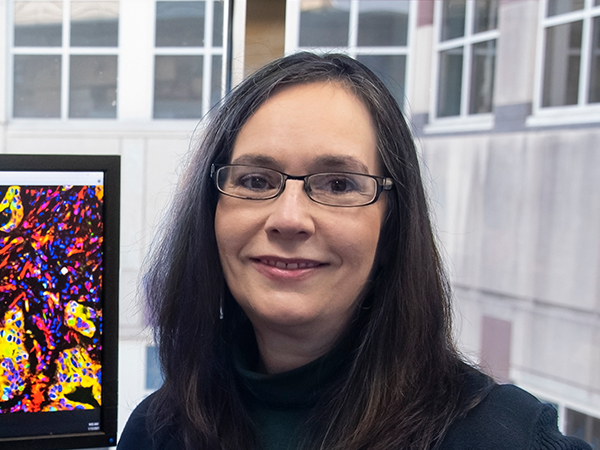3-D Vision Brings New Perspectives
When Edna Cukierman, PhD, obtained an independent research position and decided to apply for a cancer research grant, she had one problem: “I didn’t know anything about cancer,” she recalls.

She did have a track record, however. In doing post-doctoral research at the National Institutes of Health, she and her colleagues had explored the cell surface structures that mediate cells’ interaction with the microenvironment. They developed a system to go beyond the usual two-dimensional laboratory models into three dimensions, and they found important differences in the biological and cell-signaling roles of the adhesions formed by fibroblasts in a three-dimensional culture.
In a 2001 paper in Science magazine, Cukierman and colleagues discussed the three-dimensional system and their research findings about the extracellular matrix. They called the distinctive structures they discovered “3-D matrix adhesions.” The paper was considered so significant that the journal carried a separate commentary on it.
The discovery of the 3-D matrix adhesion while she was a post-doc at NIH earned her the independent position at Fox Chase Cancer Center in Philadelphia, where research is conducted on a wide range of topics not necessarily involving cancer.
She wanted to use her new system to study fibroblasts – the cells that are the biggest contributors to extracellular matrices — and the interaction of fibroblastic cells with cancer cells.
“I wanted to test the idea that if fibroblasts from different organs are able to derive different types of matrixes and have different types of functions, then the fibroblasts from the same organ that are affected by cancer, versus the ones that are not affected by cancer, will also be different from each other,” she says. Her 3-D modeling system, she thought, would allow her to mimic in the lab the processes that occur in vivo.
In 2004, she applied for the AACR-Pennsylvania Department of Health Career Development Award in Basic Cancer Research and got it.
“AACR really believed in my crazy thought,” she recalls. “I was very much to the fringe for cancer research, until AACR recognized that people who come from different disciplines may have something to contribute. And they really welcomed me. By giving me that grant, they told me that what I am doing may make a difference.”
“This was my first grant that allowed me make that step from truly basic scientist to one that may have some focus on the tumor microenvironment,” she says. “It opened that door to me.”
Her research struck gold. She showed that her lab-created 3-D matrices are capable of inducing differentiation in fibroblasts, thereby supporting the growth and development of tumors. She published her results in the American Journal of Pathology in 2005.
Any system for studying the development of dense, fibrous material, of course, brings up the potential to study the stroma that surrounds tumors of pancreatic cancer. Pancreatic stroma is so dense that it squeezes blood vessels shut, leaving the tumor to seek nutrition from the microenvironment itself. The microenvironment also becomes extremely immunosuppressive, shutting down one of the body’s key defenses against cancer.
“Pancreatic cancer is the poster child of the tumor microenvironment,” Dr. Cukierman says. She has focused closely on pancreatic cancer for several years.
Her continuing research led to a protein known as NetG1, which plays a key role in promoting the development of pancreatic tumors. However, it seems to be vulnerable to an antibody.
“Using an antibody that neutralizes the protein, we can get animals to shrink their tumors and we find tumor necrosis and tumor death and increased infiltration of immune cells that come and get rid of all that,” she says.
In a paper published recently in AACR’s journal Cancer Discovery (and also the subject of a commentary), Dr. Cukierman and colleagues described the stroma as a “viable therapeutic option” in pancreatic ductal adenocarcinoma, the most common form of pancreatic cancer.
Dr. Cukierman followed a winding path to scientific success. Born in Mexico, the daughter of a physician, she took her undergraduate and graduate education in Israel before moving her family to the United States to work at NIH. She studied fibroblasts originally as a way of getting into advanced microscopy, wasn’t really a cancer scientist when she moved to a cancer center, and continues to straddle both basic and translational research.
“Giving money to the basic discoveries is feeding the pipeline,” she says. “If we don’t do that, there’s not going to be basic discoveries to translate.”